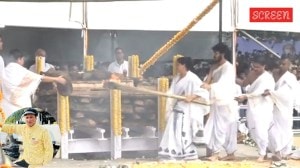The Raja, Up, Close and Personal
The name Vishwanath Pratap Singh brings up a whole lot of images. The most powerful among them being the Mandal Commission, the HDW submar...

The name Vishwanath Pratap Singh brings up a whole lot of images. The most powerful among them being the Mandal Commission, the HDW submarine and his loyalty to Indira Gandhi during the Emergency all political, and then maybe, as an afterthought, his life as an artist which ‘V P Singh, the politician’ decided to make public only recently. So, when you hear about the The Art of the Impossible: A Portrait of V P Singh, it is the subject that piques one’s curiosity. A documentary by Delhi-based freelance-writer and art critic Juliet Reynolds focussing on the life of India’s seventh Prime Minister, as a politician, painter and a poet it was screened at the NCPA on January 18.
Taking cue, the first question you confront the firebrand filmmaker with is why V P Singh. “Well, I had met him a couple of times at different art gatherings. I was always very curious about this phenomenon who was a painter and a politician. And when I met him two years ago for a story that I was writing for a London-based newspaper, I found him very willing to talk about his art. It was then that I began thinking about making a film on the creative side to V P Singh,†reveals Reynolds.
Only the final product showed much more than that, and, as a result, much less in substance. It talked about Singh’s adoption by the Raja of Manda, his marriage, his leaning towards the sciences in spite of his education in humanities, his paintings and poetry and his unforgettable innings in Indian political history. But just about. “This was the first time when I got involved in something without realising what I would be getting out of it. I have never done that before. When we began shooting in January last year, Singh became more and more willing to talk about his life as a politician. And my canvass began to grow bigger and bigger. I realised it would be stupid of me not to include this aspect in the film when he was so ready to talk about it,†she says.
Forty minutes, however, proved too short a time to capture his entire persona, it seems. For, in trying to bring out the contradictions between the painter and the politician, the result has been… sort of incomplete. True, she has a team of commentators V P Singh’s biographer Seema Mustafa, art critic and political activist Suneet Chopra, broadcaster Mark Tully to provide various shades to the film. But the film is somewhat wishy-washy, simply because the real subject of the film does not stand up is it V P Singh the politician or V P Singh the artist, or is it the painter who is also a politician and the politician who is also an artist? What is the focus on? If it is all of the above, as it appears to be, then a more lengthy documentary and a more focussed script could have lent the film the much-needed meaning.
“It is not true that the film lacks focus,†defends Reynolds. “The canvass got bigger while I was shooting. But to say that the focus was shifting is absolutely not right. It was never intended to be a blow-by-blow account on Singh’s life. It is the portrait of a man set against the canvass of his life. I have interwoven his poetry, his politics and his art in the film. I have used them as pauses and breaks in the narrative and I never wanted to ignore the political side to him,†she says. It is true that any film on a maverick personality such as V P Singh cannot talk about just one aspect of his life. And if it does, it definitely cannot ignore the era as a Congressman and then as a Janata Dal politician. However, they need more than touching upon. They need analysis and in-depth research. But here the painter and the poet get precedence over the politician, which is ironical because it is the Singh’s political career that provides the contradiction that Reynolds is looking for. The film claims toexamine how Singh’s creativity is not restricted to his paintings and poetry alone, but as he himself says in one of his poems: “My past itself is so overpowering, what can I say about my future?â€
Cutting the long story short, one is therefore left asking for more. As Reynolds realised a little later, there was no keeping Singh away from politics altogether “he is a politician through and through,†says one of the commentators. She had already held screenings of the film when he announced his return to politics by taking up the cause of slum-dwellers in Delhi. Lately, he has taken up cudgels on behalf of farmers, who, he believes, are getting a raw deal because of the Vajpayee government’s policies by lowering subsidies and allowing liberal import of agricultural products. “I had to do an update and add all this later. I am not happy with the way it looks, though,†Reynolds admits.
And has VP Singh himself seen the film? “Yes, he saw the first version when it was 90 per cent ready. He liked the photography a lot. But at times, when he was being criticised, he winced a little. I think he took it very well.†An exclusive screening for Janata Dal party members will be organised shortly.
Photos



- 01
- 02
- 03
- 04
- 05




























